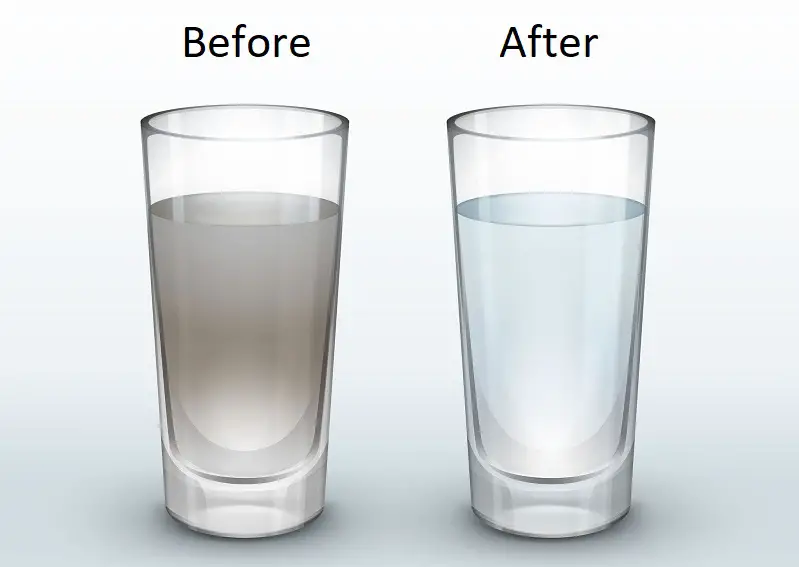UPDATED: July 23, 2022
You just installed your brand new reverse osmosis drinking water system, you are looking forward to your first taste of the pure-tasting reverse osmosis water and you start to fill up your first glass. Then your smile goes away as you see that the water coming out of your new RO is cloudy, WHAT’S WRONG?
When a new reverse osmosis system is first installed, or when the filters are changed, there will be air bubbles trapped within the system. These air bubbles will make the water appear cloudy. As these air bubbles dissipate, the water will become clear.
Cloudy water often has a very simple explanation and the problem can be solved without much effort, but sometimes there can be more to it. Read on and let’s see if we can find out why your reverse osmosis water is cloudy.
Where does the cloudiness come from?
Just like the bubbles that you see when you open a bottle of soda, trapped gasses can come out of the water once it is no longer under pressure. Air that is high in oxygen content will often cling to surfaces inside your reverse osmosis, and come out when you fill your glass.

Tested and certified by NSF International against NSF/ANSI standard 42 for the reduction of 94.2% chlorine, taste, and odor, and NSF/ANSI 372 for lead-free material. You are ensured of a safe and reliable drinking experience at all times.
When a reverse osmosis drinking water system is first installed, the filters, tubing, and any other stages that are part of the system will be empty and therefore full of air that can get trapped within the system.
Even when the water has been turned on to the system, air bubbles can collect on the walls and fittings of the system, and may not be purged out when the system is first used. These air bubbles may take a while before they are all cleared, so some cloudy water may occur for a short while.

How can I stop these air bubbles from forming?
Using a sanitizer when changing the filters of your reverse osmosis system can help to keep the inside surfaces of your reverse osmosis free of particles that allow air bubbles to accumulate.
Also, when changing your reverse osmosis filters, fill the filter housings to the top with water to prevent any extra air pockets when putting the filter housings back on.
If your reverse osmosis filters are enclosed inside a housing where you replace the entire housing, fill the housings as much as you can by tilting the housing at a 45-degree angle under running water.
Filling your reverse osmosis filter housings with cold water will generally reduce the amount of air that can get left in your system as warm water will retain dissolved oxygen better than cold water.
And I recommend emptying your reverse osmosis systems storage tank and letting it trickle for a good 10 minutes before shutting it back off and then letting the tank fill for a few hours before using.
What if the cloudy water from my RO won’t go away?
If you find that your reverse osmosis water remains cloudy for several days after you have changed your filters, run the water until it goes down to just a trickle.
This will remove the water from the storage tank so the system can start to fill it with fresh water that should be free of excessive air bubbles.
If you find that the cloudy water continues and your water does not clear up after sitting for a few minutes, check the TDS (Total Dissolved Solids) in your reverse osmosis water and compare it to the TDS of your regular tap water.
If you find that your reverse osmosis water has a TDS that is above 10% of what your regular tap water is, your reverse osmosis membrane may need to be changed.
If there are holes or tears in your reverse osmosis membrane, it will no longer be able to filter out the dissolved solids that it is supposed to leaving the water coming from your tap containing minerals that may make it appear cloudy.
Having a reverse osmosis drinking water system in your home is a great way to provide crystal clear drinking water for your family. Change your filters regularly and flush out the storage tank twice a year and it should give plenty of quality water for many years.
If you are going to do any work on your reverse osmosis drinking water system, check out my article on What I Use When I Work On A Reverse Osmosis System!
Understand What’s In Your Water!
Easily check that your water is free of hard minerals!
Know if your water contains dissolved iron!
Check the Total Dissolved Solids in your water!
Get more facts about your water!



PAUL, Good information also keep in mind the faucet can cavitate the water causing air bubbles. Cracking the faucet 1/2 open 0r a 1/4 open will cavitate the water causing air to come out of solution verses opening the faucet wide open which would deliver the water faster without much cavitation causing less air to come out of solution.
Hey Dana and thanks for the tip!
I will be sure to add that info to my article.
Thanks again!
Paul